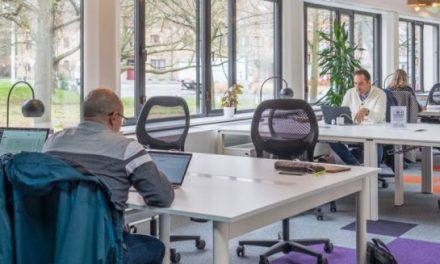Hybrid work models are quickly becoming the norm, with their popularity boosted by studies showing numerous psychological benefits for employees. This greater level of autonomy and flexibility has transformed the workplace, resulting in higher employee satisfaction, improved well-being, and higher productivity.
By gathering insights from the latest psychological research and data, this guide will outline the links between hybrid work models and better job satisfaction, teamwork, and motivation. We will consider a range of insights that outline the psychological advantages of a hybrid work policy and its positive impact on mental health.
What is a Hybrid Work Model?
Hybrid work models allow employees to have more flexibility by giving them the opportunity to work from home or in the office. Some hybrid solutions are more flexible than others, with no standard rule on how many days employees should be in the office. This depends on the requirements of the business.
Hybrid work models are proven to offer a better work-life balance when compared to traditional, fully office-based models. This often results in higher productivity, better employee engagement, and improved job satisfaction, thus boosting employee retention rates.
A recent study involving eighteen countries showed that 66% of respondents were in favor of hybrid working.
Hybrid Work Advantages
Although many employers like to see staff on-site, many also understand the benefits of hybrid working which include:
- Giving employees more control over their working hours enables a better work-life balance that boosts well-being and job satisfaction.
- Employees can work when they feel the most productive and are not tied to a 9-5 schedule. For many people, their cognitive abilities are at their peak between 8 am and 2 pm.
- Hybrid models allow businesses to build an international workforce that is not constrained to traditional office hours. Offering fully remote opportunities allows recruiters to tap into a much wider and diverse talent pool.
- Office space can be downsized, reducing expenditures such as rent, utility bills, and other operating costs.
However, a reduction in costs is not a guarantee, in some instances, startup founders need to invest in new software, IT devices, and cybersecurity, such as having to pay higher pentesting costs. Remote working requires stricter protocols to deal with a wider attack surface and the likelihood of more security incidents due to team members being unsupervised and more prone to mistakes.
Hybrid Working: Work-Life Balance
Many people have busy social lives that involve juggling seeing friends, spending time with family, and participating in hobbies, sports, and other interests. However, work can significantly reduce the amount of free time a person has, especially when you take into account long commutes which can see a person lose 3 hours a day in some circumstances.

This lack of free time can harm a person’s mental health and general well-being. Commuting also brings a financial burden, particularly for people who are required to drive long distances each day. Between rising gas prices, car maintenance, and parking, costs can add up.
Even public transport can come at a high cost if a person needs to use it twice a day, five times a week. Furthermore, bad weather or unexpected industrial action can also result in delays and cancellations which can cause stress.
This traditional working week can result in a person having trouble sleeping, leading to fatigue and burnout. As a result, a person’s evenings and weekends become a period of recovery rather than a time to enjoy themselves.
Hybrid workplaces remedy this lack of flexibility, providing more opportunities for self-care and to enjoy their free time away from work. By creating a more balanced work schedule, hybrid work models mean a person has to commute much less, can have a healthier sleep routine, and can maximize their evenings and weekends. This is not only a positive for the employee as a well-rested, less-stressed, happier employee has more focus and is more productive.
In a recent McKinsey study, 58% of employers said they noticed an increase in individual productivity by adopting a hybrid working model.
Other Health Benefits of Hybrid Working
The psychological impact of hybrid working can also be elevated by improvements in physical well-being. A study based on the Coronavirus pandemic and remote working showed that hybrid workers exercise for 4.7 hours a week compared to just 3.4 hours prior to the pandemic. Meanwhile, reduced commutes have led to an extra 71 hours of sleep each year.
With more exercise and additional time to cook healthier meals, 42% of hybrid workers have lost between 11-21 pounds, while 23% have lost more than 22 pounds. By prioritizing better sleep, more exercise, and healthier eating, hybrid workers can not only benefit from an improved mental state but they can also look and feel physically healthier.
Daily commuters are often forced to make do with ready meals, quick snacks, and takeout due to a lack of time and a general tiredness. A better diet and healthier eating habits are one of the overlooked factors of hybrid working and is one that is vitally important.
Hybrid Working: Mental Health Challenges
As with any exploration, the challenges of hybrid work models must also be explored but it should be noted that the advantage of a hybrid model is flexibility. This means that if an employee wishes to regularly come to the office, they can!
Some individuals feel a degree of loneliness when working at home and for some, this can have a serious impact on their mental health. Many people enjoy regular colleague engagement and the community aspect of working in an office. Without this, a person could go days at a time with minimal to no social contact. Of course, online video conferencing tools, phone calls, and emails can ensure constant collaboration, but for a lot of people, this is a poor substitute.
With the rise of AI, a person can regularly speak to a machine more than they do to a fellow human being during their working day. Research shows that the AI market size is expected to grow by nearly 20x from 2023 to 2030, up to nearly $2 trillion.
The delivery of company and technical training is also a consideration, with many people preferring to learn by doing in a practical setting. In traditional offices, it’s usually the IT/technical teams who train employees on how to use new tools and software. Just emailing someone a video tutorial on using an authentication tool or learning to merge PDF files may not be enough.

Implementing a Successful Hybrid Work Model
For a successful hybrid work model, employers need to ensure there are robust processes in place to ensure mental well-being. When working from home, some people struggle to shut off from work, with their working day and evenings blending into one. This can result in people working far longer than their contracted hours. Essentially, a person’s job invades their home and family time.
This means it is important to educate employees on the risks of hybrid working, encourage them to log off from their computer at a set time each day, allocate a designated work area in their home, and resist the temptation to check emails and messages outside of working hours.
Without these guidelines and policies, hybrid workers may not benefit from a hybrid working model, with home working failing to have a positive impact on their mental and physical health.
To be successful, a hybrid work model must strike a balance between productivity and well-being. This means creating a positive working environment while still achieving business goals.
It is important to ‘marry’ the tenets of workplace psychology and sociology, while at the same time supporting each decision with business analytics properly, creating a bespoke model that meets the requirements of your organization and forming a compromise between employees and employers.
Conclusion
Hybrid working can have a positive impact on an employee’s mental health by contributing to a better work-life balance and improving mental health. By removing or reducing the commute to work each week, a person has more time to sleep, socialize, cook healthy meals, and exercise.
It needs to be noted that a hybrid work environment is not ideal for every employee and a level of flexibility should be maintained so that anyone who wants to regularly work from the office is allowed to. Some people can feel lonely when working from home and miss human interaction.
Others can fail to separate their work from their home life, resulting in their career taking over their home life. Therefore, measures need to be taken to make sure hybrid working models guarantee the free time for employees they were created for.









